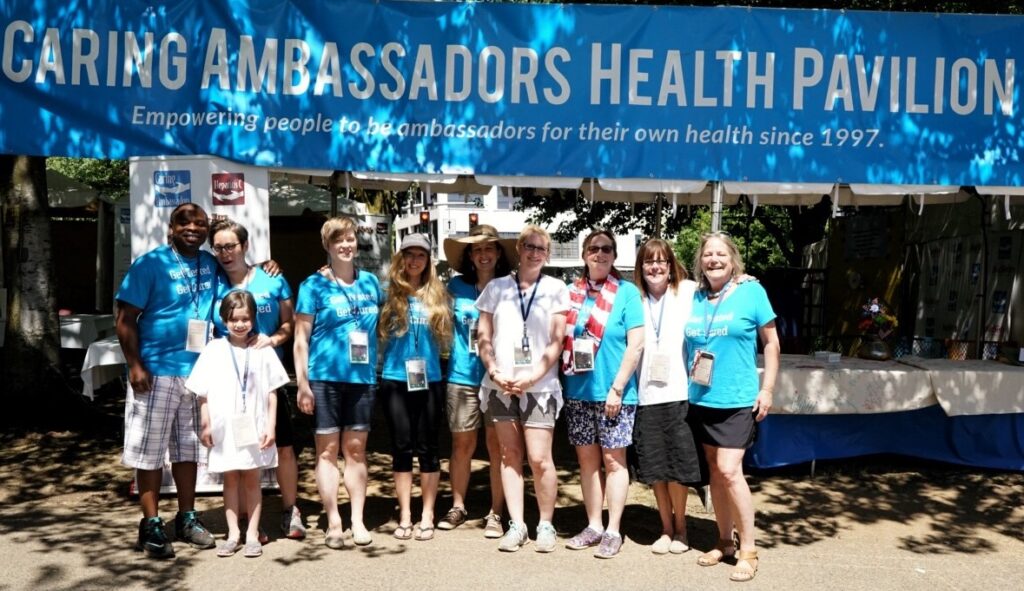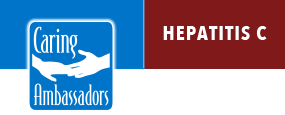HCV Screening Event Tips
The Caring Ambassadors Program is providing this information to help you host a successful hepatitis C screening event.
The information is based on our experience hosting outdoor screening events. However, each event is different and you will need to customize your procedures according to the venue, length of the event, target audience, and other factors.
We welcome your comments and suggestions.
Download our Parts & Pieces: HCV Screening & Counseling Guide

Getting Ready
9 TO 12 MONTHS IN ADVANCE
Identify your target audience.
Hepatitis C affects people from all walks of life. The first step to a successful counseling and screening event is identifying the target group. This should take place well in advance of procurement of funds or booking a venue. The target audience will drive many of the decisions you make about your event, most importantly, choosing a venue.
Identify possible venues.
Once the target population has been decided upon, start considering possible venues. For example, if the target audience is the homeless population, the first step is to identify a venue that is frequented by and accessible to this population.
When considering a venue, ask yourself a series of questions:
- Is this site suitable for counseling and testing?
- Is there sufficient privacy?
- Is there enough space?
- Are people in this venue in the right frame of mind to think about being screened for HCV?
- Are people in this venue likely to be capable of informed consent?
Decide what type of antibody screening test will be used.
- Are you going draw blood (venipunctures) or use a fingerstick test kit?
- If you intend to draw blood, do you have the expertise to do it, or are you going to hire phlebotomists?
- If drawing blood, do you have facilities to store the blood until transport to the laboratory?
Develop project plan and budget.
- Planning should include outcome measures and tools for measuring those outcomes.
Make requests for funding as needed.
- Consider possible in-kind donations in your budget and development planning.
6 TO 9 MONTHS IN ADVANCE
Liability insurance is an obligation every organization hosting an event must take seriously. It’s important to protect your staff, volunteers, and your organization.
Identify staffing needs
- How many people do you expect to participate in the event?
- How many staff members or volunteers will be needed to reach the objective?
- What will your strategy be to recruit volunteers, if needed?
Reserve a venue.
Be sure you understand all requirements and restrictions of the venue before signing a contract.
Develop a communications strategy.
Even the most carefully planned event will be successful unless people come to the event!
- Consider a multimedia approach that may include radio, television, newspaper, and the Internet to let people know about the event.
- Advertising may be a consideration if it is within your budget.
- Are there other organizations in your area that may be willing to partner in the promotion of the event?
Develop a health services resource list.
Millions in the U.S. are uninsured or underinsured. It is very important to have a list of community resources available for people whose antibody screen is positive or indeterminate.
- What options are available for confirmatory or repeat testing?
- Where are the community clinics in the area?
- How do people begin the process of applying for Medicare or Medicaid?
- Are there other local nonprofits that may be able to assist clients in securing services?
3 MONTHS IN ADVANCE
Begin event promotion.
Write media advisory.
- Prepare/update your media contact list.
- Develop advertising copy; be sure to check with publications in which you’ll be running ads about requirements regarding formats/software for submission of the advertising copy.
Finalize testing arrangements.
- Order test kits if that’s the option you’ve chosen.
- Finalize arrangements with phlebotomists or other blood collection and testing personnel if you’ve decided to contract directly with a laboratory to conduct the specimen collection and testing.
Finalize volunteer recruiting (if needed) to ensure the event is fully staffed.
4 TO 6 WEEKS IN ADVANCE
Post the event on local community calendars.
Conduct volunteer training.
- Hand outs are very helpful even if an in-person training session is conducted. Written materials can be referred to later to reinforce the messages of the training session.
Collect/order your informational, outreach, and promotional materials to be distributed at the event.
- Make sure you have enough materials (e.g., brochures, business cards, fliers, etc.) Order materials well in advance if needed; last- minute printing can be very expensive.
Print/order forms for screening and consent.
- Depending on the number of participants expected, price the cost of printing in-house, in-house copying, or using a vendor.
2 WEEKS IN ADVANCE
Send volunteer instruction packages.
- Volunteer instruction packages should include event location, directions, parking information, dress code, hours of operation, specific scheduled hours, and contact information for on-site event coordinators.
Secure supplies as needed.
- Check the supplies list to make sure you have everything needed.
1 WEEK IN ADVANCE
Send out press release and a reminder media advisory.
Purchase any perishables needed for the event.
- If hosting a multi-day or extended day event, consider purchasing snacks for staff/volunteers or giving a small allowance for the same.
Pack all event supplies into sturdy boxes
Below are some sample forms used by Caring Ambassadors Program.
Sample Supply List
Sample screening and consent form
Sample Volunteer letter
Sample Out Reach Instructions
It is helpful to provide fact sheets to your outreach staff and volunteers prior to the event, and to have hard copies available during the event.
